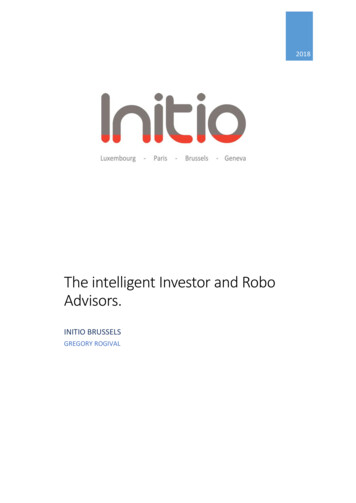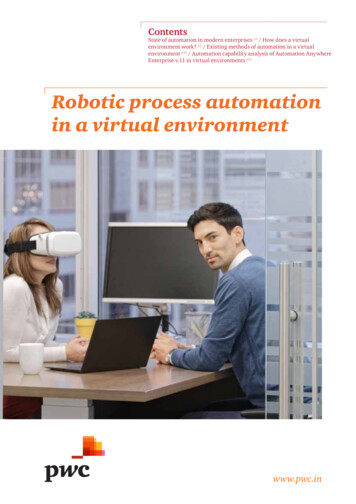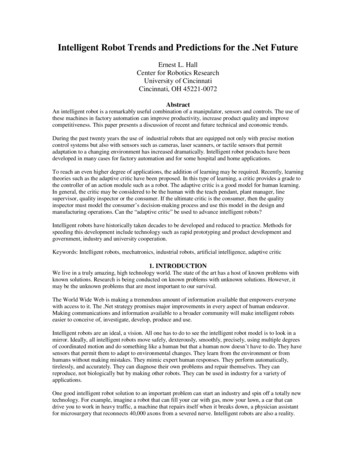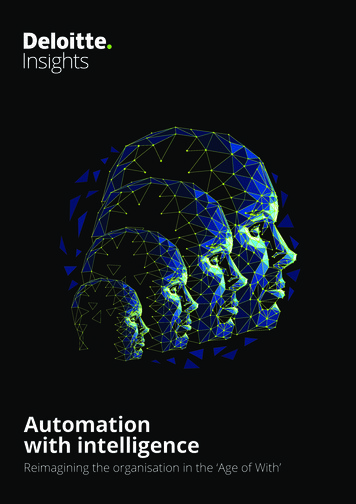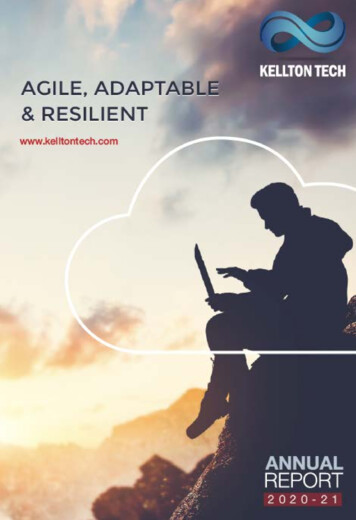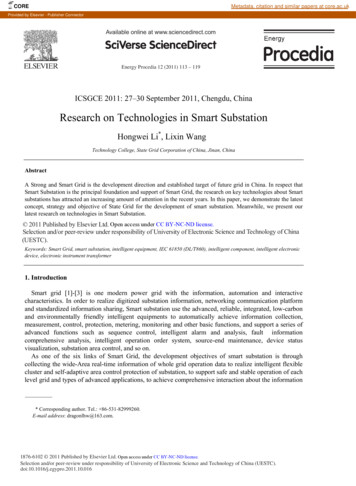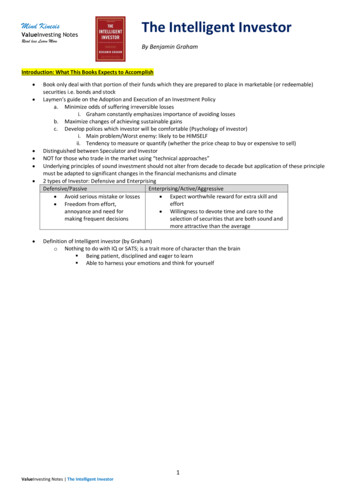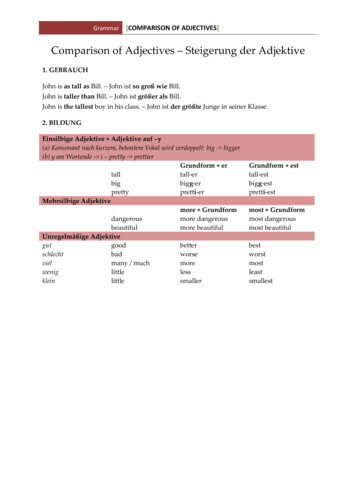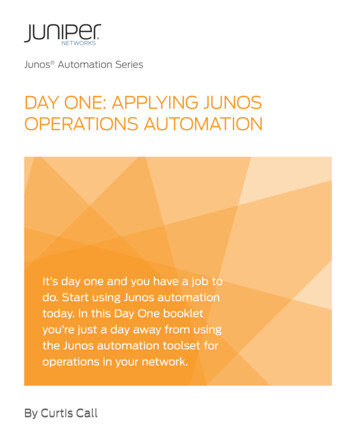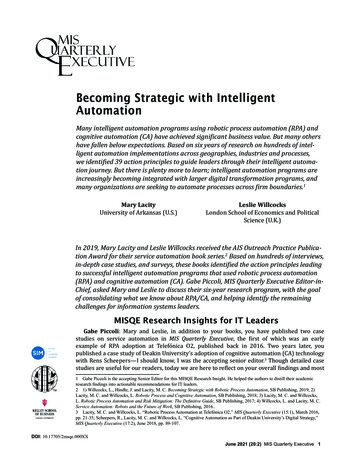
Transcription
Becoming Strategic with IntelligentAutomationMany intelligent automation programs using robotic process automation (RPA) andcognitive automation (CA) have achieved significant business value. But many othershave fallen below expectations. Based on six years of research on hundreds of intelligent automation implementations across geographies, industries and processes,we identified 39 action principles to guide leaders through their intelligent automation journey. But there is plenty more to learn; intelligent automation programs areincreasingly becoming integrated with larger digital transformation programs, andmany organizations are seeking to automate processes across firm boundaries.1Mary LacityUniversity of Arkansas (U.S.)Leslie WillcocksLondon School of Economics and PoliticalScience (U.K.)In 2019, Mary Lacity and Leslie Willcocks received the AIS Outreach Practice Publication Award for their service automation book series.2 Based on hundreds of interviews,in-depth case studies, and surveys, these books identified the action principles leadingto successful intelligent automation programs that used robotic process automation(RPA) and cognitive automation (CA). Gabe Piccoli, MIS Quarterly Executive Editor-inChief, asked Mary and Leslie to discuss their six-year research program, with the goalof consolidating what we know about RPA/CA, and helping identify the remainingchallenges for information systems leaders.MISQE Research Insights for IT Leaders1,2Gabe Piccoli: Mary and Leslie, in addition to your books, you have published two casestudies on service automation in MIS Quarterly Executive, the first of which was an earlyexample of RPA adoption at Telefónica O2, published back in 2016. Two years later, youpublished a case study of Deakin University’s adoption of cognitive automation (CA) technologywith Rens Scheepers—I should know, I was the accepting senior editor.3 Though detailed casestudies are useful for our readers, today we are here to reflect on your overall findings and most1 Gabe Piccoli is the accepting Senior Editor for this MISQE Research Insight. He helped the authors to distill their academicresearch findings into actionable recommendations for IT leaders.2 1) Willcocks, L., Hindle, J. and Lacity, M. C. Becoming Strategic with Robotic Process Automation, SB Publishing, 2019; 2)Lacity, M. C. and Willcocks, L. Robotic Process and Cognitive Automation, SB Publishing, 2018; 3) Lacity, M. C. and Willcocks,L. Robotic Process Automation and Risk Mitigation: The Definitive Guide, SB Publishing, 2017; 4) Willcocks, L. and Lacity, M. C.Service Automation: Robots and the Future of Work, SB Publishing, 2016.3 Lacity, M. C. and Willcocks, L. “Robotic Process Automation at Telefónica O2,” MIS Quarterly Executive (15:1), March 2016,pp. 21-35; Scheepers, R., Lacity, M. C. and Willcocks, L. “Cognitive Automation as Part of Deakin University’s Digital Strategy,”MIS Quarterly Executive (17:2), June 2018, pp. 89-107.DOI: 10.17705/2msqe.000XXJune 2021 (20:2) MIS Quarterly Executive 1
Becoming Strategic with Intelligent AutomationFigure 1: Automation Continuumimpactful lessons from your six-year researchprogram. To help orient the audience, please startby explaining the necessary terminology.Mary Lacity: We research how enterprisesautomate services using a variety of digitaltechnologies. When we began studying thisspace back in 2014, we encountered a dizzyingarray of automation products marketed asscripting tools, software robots, robotic processautomation, artificial intelligence, desktopautomation, cognitive computing, businessprocess management automation and machinelearning, to name a few. The market was veryconfusing to practitioners and to us. To makesense of the space, we looked at how these toolsworked, the type of data used as input, how theyprocessed data and the type of results produced.Based on this work, we identified a continuum ofautomation tools (see Figure 1), with the realmof robotic process automation (RPA) at one endand the realm of cognitive automation (CA) at theother. Many commonly call the latter “artificialintelligence” (AI).The realm of RPA consists of tools thatautomate tasks that have clearly defined rulesfor processing structured data to producedeterministic outcomes. For example, a “softwarerobot” can be configured to process tasks theway humans do, by giving it a logon ID, passwordand playbook for executing processes. RPA toolsare ideally suited for automating those mindless2MIS Quarterly Executive June 2021 (20:2)“swivel chair” chores performed by humans,like taking structured data from spreadsheetsand applying certain rules to update an ERPsystem. Leslie had the early insight that RPAtools “take the robot out of the human,” meaningthat the tedious parts of a person’s job couldbe automated, leaving the human to do moreinteresting work that requires judgment andsocial skills. His insight resonated so stronglywith practitioners, that we had to chase downmore than one supplier and conference organizerthat had adopted the phrase as their marketingslogan without crediting Leslie. The top RPAproviders by market share as of 2020 (and likelyin 2021) were Automation Anywhere, Blue Prismand UiPath.Leslie Willcocks: It is important to note that,because of the consequences for ease of scaling,these software providers do not all provide thesame thing. There are variants of RPA rangingfrom desktop assisted RPA, to enterprise RPA selfdevelopment packages, to cloud-based services.The realm of cognitive automation consists ofmore powerful software suites that automate oraugment tasks that do not have clearly definedrules. We do not like to call such software“artificial intelligence” because we believe the AIlabel overstates what these tools do.With CA technologies, inference-basedalgorithms process data to produce probabilisticoutcomes. The realm of CA includes a varietymisqe.org 2020 University of Minnesota
Becoming Strategic with Intelligent Automationof tools, such as deep learning algorithms andtools that analyze data based on supervised andunsupervised machine learning. Some of thealgorithms have been around for decades but thecomputational power needed to execute themon big data has only recently become available.The input data for CA tools is often unstructured,such as free-form text, either written or spoken.For example, at Deakin University, CA was usedto answer natural language inquiries fromstudents. However, the input data can also behighly structured, such as the pixels in an image.Google’s Machine Learning Kit, IPsoft’s Amelia,IBM’s Watson suite and Expert Systems’ Cogitoare examples of CA tools.People refer to “strong” AI as using computersto do what human minds can do.4 The vastmajority of organizations are a long way off fromthat! In our view, however, “AI” is widely andmisleadingly used, especially by vendors, as anumbrella term for RPA and CA, as well as for muchmore advanced software that has not even madeit out of the laboratory. The claims by vendorsare not helped by the misleading metaphor ofcomparing the human brain with computing.Most “AI applications” in businesses today canbe described as “weak, weak AI”—algorithmsdriven by massive computing power. This is not“intelligence;” it is machine learning; we call it“statistics on steroids.”5 Though the realm of CAis vast, our research examined how the toolswere used to automate or augment back-officeprocesses and customer-facing services, in linewith our early interest in RPA. Typical exampleswe witnessed included processing medical claims,answering customer queries and categorizinguser requests to route them to the humans whocould help.Gabe Piccoli: What is the history of RPA/CAtechnology?4 For a more comprehensive coverage of the types of strong andweak AI, see Benbya, H., Davenport, T. H. and Pachidi, S. “SpecialIssue Editorial: Artificial Intelligence in Organizations: Current Stateand Future Opportunities,” MIS Quarterly Executive (19:4), December 2020, pp. ix-xxi.5 See: 1) Willcocks, L. “Why Misleading Metaphors Are FoolingManagers About the Use of AI,” Forbes, April 23, 2020, available ng-managers-about-the-use-ofai/?sh 7ec5fec5de1f; and 2) Fersht, P. Greetings from Robotistan,Outsourcing’s Cheapest New Destination, Horses for Sources,November 1, 2012, available at https://www.horsesforsources.com/robotistan 011112.Mary Lacity: Let’s begin with a quick historyof RPA. In 2012, Phil Fersht, founder of theoutsourcing consulting firm Horses for Sources(HfS), used the term RPA in a provocative reportentitled Greetings from Robotistan, Outsourcing’sCheapest New Destination. It highlighted a U.K.based start-up called Blue Prism, which wasfounded in 2001. Blue Prism did not become wellknown until its chief marketing officer, PatrickGeary, started calling its product “robotic processautomation” sometime in 2012. That term reallyresonated with practitioners, so much so thatother automation companies started rebrandingtheir tools as RPA. By 2016, there were over twodozen companies saying they provided RPA tools,with a claimed market size of 600 million.6There was a desperate need for RPA standards,so Lee Coulter, then CEO of Ascension SharedServices, started an initiative at IEEE, and inDecember 2016 became the chair of the IEEEWorking Group on Standards in IntelligentProcess Automation. The group published thefirst standard in 2017,7 which distinguishedbetween enterprise RPA designed for anorganization and robotic desktop automation(RDA) designed for a single desktop user. BluePrism began as an RPA provider; AutomationAnywhere began as an RDA provider. Bothcompanies’ products have evolved into moresophisticated platforms that include naturallanguage processing and machine-learningfeatures.Gabe Piccoli: So where does RPA stand today,and what is the market value?Leslie Willcocks: The RPA market wasbetween 2 billion and 4 billion in 2020,depending on which consulting report you read.8Nearly every source predicts that the annualgrowth rate will be between 30% and 50 %6 Fersht, P. and Snowdon, J. RPA Will Reach 2.3bn Next Year and 4.3bn by 2022. As We Revise Our Forecast Upwards, November30, 2018, Horses for Sources, available at -2022 120118.7 IEEE 2755-2017: IEEE Guide for Terms and Concepts in Intelligent Process Automation, available at .8 See: 1) “Robotic Process Automation (RPA) Market RevenuesWorldwide from 2017 to 2023,” Statista, January 2020, availableat de-roboticprocess-automation-market-size/; and 2) Fersht, P. and Snowdon, J.op. cit., November 30, 2018June 2021 (20:2) MIS Quarterly Executive3
Becoming Strategic with Intelligent Automationfor the foreseeable future.9 C-suite prioritiesfor emerging technologies have shifted rapidlybecause of Covid-19. Though the pandemicprompted many enterprises to postponehorizon technologies like edge computing andblockchains, they became laser focused ontechnologies that produce rapid returns oninvestments (ROIs), and the top of that list wasprocess automation.10Gabe Piccoli: Moving to cognitive automation,most MIS Quarterly Executive readers are likelyfamiliar with the long history of AI, beginning inthe 1940s with the work of Warren McCullochand Walter Pitts on neural nets, the Turing testand the Dartmouth Conference in 1956, and I amsure we all remember when IBM’s Deep Blue beatGary Kasparov in chess in 1997.Mary Lacity: Yes, and also Watson's win overBrad Rutter and Ken Jennings in Jeopardy in2011, and Google DeepMind’s AlphaGo victoryover Lee Se-dol in 2016.Gabe Piccoli: This is clearly a booming areaof interest. The MIS Quarterly Executive specialissue in December 202011 addressed some ofthe organizational challenges brought aboutby AI. Given your focus on service automation,what challenges of CA technologies have youdocumented in your recent work?Mary Lacity: Organizations find it difficultto adapt CA tools designed for a specificcontext like chess, Jeopardy or Go for use inother contexts like processing health records,mortgage applications and calls to helpdesks.Early enterprise adopters experienced painfuland expensive implementations, mostly due tothe data challenge. Our case companies adoptedCA tools with supervised machine learning, whichneeds thousands of labeled data examples toenable the machine-learning algorithms to reachan acceptable level of proficiency. However, asmuch as 80% of an organization’s data is “dark,”meaning that the data is unlocatable, untapped9 Allied Market Research, reporting on October 13, 2020, forecastthat the RPA market at end of 2027 will be 19.53 billion—an annual compound growth rate of 36.4%. A Deloitte survey reporting inDecember 2020 predicted the RPA market would grow at 40.6% peryear to reach 25.6 billion by 2027.10 See “Enterprise Reboot: Scale Digital Technologies to Grow andThrive in the New Reality,” 2020, KPMG International and HFS Research, available at rprise-reboot.html.11 Benbya, H., Davenport, T. H. and Pachidi, S., op. cit., December2020.4MIS Quarterly Executive June 2021 (20:2)or untagged. Enterprise adopters of CA toolsfirst had to create new data and clean up dirtydata that was missing, duplicated, incorrect,inconsistent or outdated. They also struggledwith “difficult data,” which we define as accurateand valid data that is hard for a machine to read—for example, fuzzy images, unexpected data typesand sophisticated natural language text. In our CAcases, much of the work to sort out data problemswas done by tedious human review.But we did find examples of organizations thateventually got value from their CA adoptions,including Deakin University, Zurich Insuranceand KPMG. As best practices emerge, moreorganizations are finding success, thoughCA implementations still tend to be islandsof automation rather than enterprise-widedeployments. The size of the CA market in 2020is reported to be somewhere between 50 billionand 150 billion.12Gabe Piccoli: So, CA is much bigger thanRPA in terms of market size. You mentioned aconvergence of RPA and CA. Would you explainthat?Leslie Willcocks: RPA and CA havedifferent histories that are now converginginto what practitioners are calling “intelligentautomation.” The idea of intelligent automationis to institutionalize a well-designed automationprogram using a platform for pluggable tools thatare best-in-class. In our case studies, businessvalue was not derived from the selection of onetechnology or service provider, but throughthe ability to identify and connect differenttechnologies that maximize the full potential ofmodern automation technologies. At present,though, software providers are at different stagesin developing automation platforms that canharness both RPA and CA technologies. Someenterprises buy best-in-class tools and use theirown platforms to integrate them internally.Gabe Piccoli: Would you give an example of anintegration of RPA and CA?12 See, for example: 1) Artificial Intelligence Market Size, Share& Trends Analysis Report, Grand View Research by Solution(Hardware, Software, Services), by Technology (Deep Learning,Machine Learning), by End Use, by Region, and Segment Forecasts,2020-2027, July 2020, available at s/artificial-intelligence-ai-market; and 2) “IDCForecasts Strong 12.3% Growth for AI Market in 2020 Amidst Challenging Circumstances,” IDC, August 2020, available at https://www.idc.com/getdoc.jsp?containerId prUS46757920.misqe.org 2020 University of Minnesota
Becoming Strategic with Intelligent AutomationMary Lacity: IBM is a good example. IBM’sglobal IT outsourcing services business combinedthe Blue Prism RPA software with components ofIBM’s Watson technology. In one service (GlobalTechnology Services Technology, Innovation &Automation), IBM has well over 1,000 customers,and a range of automation tools, including 200RPA software licenses provided through itsLondon and Amsterdam offices.One process that IBM automated byintegrating technologies was email ticket triage.IBM’s customers have email task IDs they can useto send support requests to IBM. The requestsare typically things like “Hey, my printer is notworking” or “I’ve forgotten my password.” Anyemailed support request needs to be logged intothe ticketing system and routed to the correctgroup for resolution. This task used to be doneby humans but was taken on in 2017 by an RPAsoftware robot. The robot uses its logon ID to loginto the ticketing system. It retrieves an email,logs it into the ticketing system and engagesthe CA tool, which categorizes the issue as, forexample, “this is a network support request” or“this is a telephone request.” The CA tool typicallyhas a high degree of certainty, having beentrained on thousands of historical tickets. Whenconfidence is low, the ticket is escalated to ahuman for routing and the label is fed back to theCA tool for learning. The RPA tool closes the loopby identifying the appropriate team and routingthe ticket to the correct group.Leslie Willcocks: That example is just one ofmany. Increasingly, we see CA tools fed into RPAsoftware, which acts as the execution engine,especially in banking, insurance and financialservices organizations. A bank, for example,will have an interactive front-end chat bot fordialogue with customers, but it will draw on RPAto get the information it needs to be able to havea more accurate conversation with the customer,for example, about a stolen credit card. In thefuture, we will see even better integration of RPAand CA software, leading to automation exchangeplatforms that are increasingly cloud based.Examples already exist.Gabe Piccoli: So, we’ve talked about whatthese tools are, their histories and how they work,but how do enterprises actually get businessvalue from them?Mary Lacity: We, and others, have studiedimplementations with outcomes ranging fromwhat we describe as “value triple-wins” tocomplete failures. We think it’s most useful tofocus on success stories because practitionerslike to learn from, and hopefully mimic, theachievements of early adopters. But we alsostudied failures so we could identify the actionprinciples that differentiate outcomes.Many of our case study organizations achievedtriple wins by achieving value for three typesof stakeholder: the enterprise, customersand—most surprising of all—employees. TheAssociated Press, BNY Mellon, Bouygues, DeakinUniversity, Ericsson, EY Tax Advisory, KPMG,Mars, Nielsen Holdings, Nokia, nPower, SECBank, Shop Direct, Standard Bank, TelefónicaO2, the VHA, Xchanging and Zurich Insuranceare examples of companies that have achievedat least one source of value from each category.Aggregating these findings, we have listed thespecific benefits and sources of enterprise,customer and employee value that RPA and CAhave delivered across our case study companies(see Figure 2).Gabe Piccoli: That list seems a little too goodto be true. Can you provide some examples?Leslie Willcocks: Our two articles publishedin MIS Quarterly Executive provide detailedexamples. Keep in mind that we initially studiedknown successes to see if there was any “there”there! Our Telefónica O2 case identified the valueto the company in terms of cost savings, thevalue to customers, who received faster services,and the value to internal employees, who werereleased from dreary work to focus on moreinteresting tasks. The Deakin University casedetailed the triple win for three stakeholders:the university raised its global brand awareness,students gained faster access to critical services,and staff members were able to focus onmore interesting tasks. Further evidence fromother companies can be found in several otherJune 2021 (20:2) MIS Quarterly Executive5
Becoming Strategic with Intelligent AutomationFigure 2: Triple Wins of Service Automation Value Are Evident Across Multiple RPA andCA Implementationspublished studies, both by us and by otherauthors.13Gabe Piccoli: What do failures look like? Whatwere some of the key missteps leaders made earlyon?Mary Lacity: We purposefully startedresearching failures for our second book,Robotic Process Automation and Risk Mitigation:The Definitive Guide. It’s always hard to findcompanies willing to talk about their blunders,though there are quite a few accounts ofthe limitations as well as the benefits of the13 See: 1) Asatiani, A. and Penttinen, E. “Turning Robotic ProcessAutomation into Commercial Success: Case OpusCapita,” Journalof Information Technology Teaching Cases (6:2), May 2016, pp.67-74; 2) Davenport, T. H. and Kirby, J. “Just How Smart Are SmartMachines?” MIT Sloan Management Review (57:3), March 2016, pp.21-25; 3) Hallikainen, P., Bekkhus, R. and Pan, S. “How OpusCapitaUsed Internal RPA Capabilities to Offer Services to Clients,” MISQuarterly Executive (17:1), March 2018, pp. 41-52; 4) Lacity, M. C.,Willcocks, L. and Craig, A. Robotic Process Automation at TelefónicaO2, Paper 15/02, The Outsourcing Unit Working Paper Series, April2015, London School of Economics; 5) Lacity, M. C. and Willcocks,L., “A New Approach to Automating Services,” MIT Sloan Management Review (58:1), September 2016, pp. 40-49; 6) Lowes, P. andCannata, F. Automate This: The Business Leader’s Guide to Roboticand Intelligent Automation, Deloitte, 2017, available at tomation.pdf; 7) Schatsky, D., Muraskin, C.and Iyengar, K. Robotic Process Automation: A Path to the CognitiveEnterprise, Deloitte University Press, 2016; 8) Watson, H. “PreparingFor the Cognitive Generation of Decision Support,” MIS QuarterlyExecutive, (16:3), September 2017, pp. 153-169; and 9) Willcocks, l.,Hindle, J. and Lacity, M. C. Becoming Strategic with Robotic ProcessAutomation, SB Publishing, 2019.6MIS Quarterly Executive June 2021 (20:2)automation we are describing.14 The softwareproviders and consulting firms we wereworking with at the time, including Alsbridge(now part of ISG), Blue Prism, Everest Group,HfS, ISG and KPMG, helped us identify failurecases. We studied many enterprises whereRPA implementations failed to deliver value.Problemsincluded:employeesabotagetriggered by inappropriate human resource(HR) policies, functional failures due to poorchange management, and implementations thatirritated, rather than delighted, customers. Someorganizations had localized successes with a fewprojects, but they never succeeded in scaling andmaturing the RPA capability across the enterprise.We identified over 40 risks—which can beconsidered missteps—in the areas of strategyformulation, sourcing, tool selection, stakeholderbuy-in, project management, operations, changemanagement and maturity (see Figure 3).Gabe Piccoli: Well, that is quite sobering, butalso very useful in identifying practices that areresponsible for beneficial or poor outcomes. Ourreaders are most interested in the practices thatare unique to this technology. I am sure someof the classic practices leading to successful IT14 Examples of successes and failures can be found in: 1) Davenport, T. H. The AI Advantage: How to Put the Artificial IntelligenceRevolution to Work, The MIT Press, 2018; 2) Smith, R. E. RageInside the Machine, Bloomsbury Business, 2019; 3) Broussard, M.Artificial Unintelligence, The MIT Press, 2018; 4) Smith, G. The AIDelusion, Oxford University Press, 2018; and 5) Russell, S. HumanCompatible: AI and the Problem of Control, Allen Lane, 2019.misqe.org 2020 University of Minnesota
Becoming Strategic with Intelligent AutomationFigure 3: Common Missteps Along the Automation Journeyproject completion apply (e.g., top managementsupport). Taking those as given, what are theunique practices you found to be critical to RPA/CA success?Leslie Willcocks: Overall, we identified 39action principles that were associated with goodoutcomes (they are listed in the Appendix), one ofwhich is, as you say, Gabe, to “gain C-suite supportto legitimate, support and provide adequateresources for the service automation initiative.”Many of our action principles commonly applyto any type of organizational adoption oftechnology, such as getting stakeholder buy-inand following Pareto’s rule by automating thesmallest percentage of tasks that account for thegreatest volume of transactions. We do see valuein replicating known practices—they reaffirmwhat managers already know about successfultechnology implementations. Managers needto retain many of their practices in the face ofa new technology. But our research did revealprovocative findings and new insights.For example, many people falsely assumethe ROI from automation comes from firingemployees. While it’s true that the primary sourceof value from service automation is freeing uphuman labor, the best way to deliver, measureand communicate this value to the enterprise is“hours back to the business.” Think of it as a giftgiven back to the organization. But what will anorganization do with that gift? Most enterpriseswe studied used the freed-up labor capacityto redeploy people to other tasks within thework unit. Many of these organizations wereexperiencing high growth, and automationhelped them take on more work without hiringproportionally more workers. You can easilyimagine how valuable it is to grow efficientlyby redeploying existing employees rather thansearching for, vetting, onboarding and trainingnew ones.Gabe Piccoli: Can you explain how “hoursback to the business” is different from what wenormally think of in terms of freeing up full-timeequivalents (FTEs)?Mary Lacity: The two terms are similar,but the messaging is very different. “Hoursback to the business” calculations are based onestimating the number of hours it would take ifhumans still performed the automated tasks. Itrepresents the human capacity that is now freeto do different work. Hours back to the businessJune 2021 (20:2) MIS Quarterly Executive7
Becoming Strategic with Intelligent Automationcan be converted to FTEs, typically by dividingby 2,000, the average number of hours anemployee works per year. For example, EY’s USTax Advisory Business generated 800,000 hoursback to the business within 18 months of its RPAimplementation. If EY reported that automationsaved them 400 FTEs instead of the equivalent800,000 hours, many may interpret it as: “Weno longer need 400 people.” But that sends thewrong message, as the labor savings typicallycome from automating a portion of people’sjobs. In practice, saving 400 FTEs is more likelyto come from automating 20% of 2,000 people’sjobs.Gabe Piccoli: But surely some automationimplementations lead to layoffs?Leslie Willcocks: Well, that’s where it getsinteresting! First, we are talking here abouttime saved that can be used elsewhere in theorganization. Second, the time saved is invariablyspread across jobs. It’s partial task automation,not job loss. Third, people fail to understand thatthere is an enormous amount of extra work beinggenerated every year in organizations—in onestudy we suggest between 8% and 12%.15 Theextra work arises from the exponential explosionin data volumes, increasing audit and regulationrequirements, and bureaucracy, as well as theproblems that information and communicationstechnologies bring with them—cybersecurity isan obvious example. Increasing workloads alliedwith skills shortages have forced organizations toturn to automation as a coping mechanism, ratherthan primarily for headcount reduction.Of course, we did document some layoffs,but—perhaps surprisingly—layoffs have notbeen as widespread as one might think, especiallyduring the time frame of our study (2015-2020).Other researchers have also documented thisperhaps counterintuitive insight. Davenport andRananki found that replacing administrativeemployees was neither a primary objective nor acommon outcome of deploying RPA.16 They found15 See: 1) Willcocks, L. “Robo-Apocalypse Cancelled? Reframing the Automation and Future of Work Debate,” Journal ofInformation Technology (35:4), December 2020, pp. 286-302; and2) Willcocks, L. “Robo-Apocalypse? Response and Outlook on thePost-COVID-19 Future of Work,” Journal of Information Technology(forthcoming).16 Davenport, T. H. and Rananki, R. “Artificial Intelligence forThe Real World,” Harvard Business Review, January-February 2018,available at r-the-realworld.8MIS Quarterly Executive June 2021 (20:2)that only 22% of executives sought headcountreduction as the primary objective of “AI.” KPMGfound that, of the employees displaced by “AI,”only 14% were let go, with the rest retrained todeal with data or AI-related tasks, to work on aspecific process or in an industry domain, or toservice new business needs.17More generally, Manyinka and Burghin,identified three simultaneous “AI” impacts:jobs lost, jobs gained and jobs changed. In theirmidpoint scenario, jobs lost by 2030 coulddisplace 400 million workers, but these losseswould be more than compensated for by thebetween 555 million and 890 million jobs gained.They also predict that many more jobs would bechanged by automation than would be lost.18Mary Lacity. I think it’s worth sharing thefindings from surveys we conducted with ourcolleagues John Hindle and Shaji Khan. Wecarried out two surveys—one in 2017 of 124senior managers and one in 2018 of 60 serviceautomation adopters. We asked respondents,“What does your organization do with the laborsavings generated from automation?” Only22% of the respondents in the 2017 surveyand 15% in the 2018 survey indicated thattheir organizations laid off employees as aconsequence of automation. Other enterprisesdid reduce headcount, but not through layoffs.Instead, they took a gentler approa
June 2021 (20:2) MIS Quarterly Executive 1 MISQE Research Insights for IT Leaders1,2 Gabe Piccoli: Mary and Leslie, in addition to your books, you have published two case studies on service automation in MIS Quarterly Executive, the first of which was an early example
